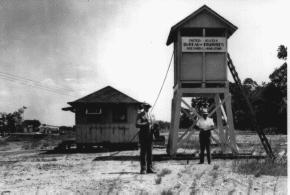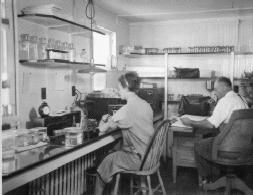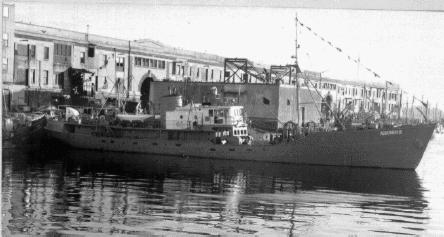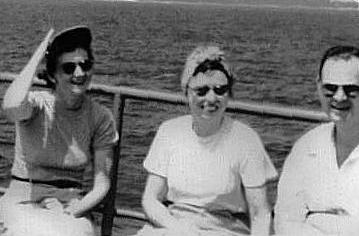1940
The 1940 Reorganization Plan No. III, effective June 30th, merges the
Bureau of Fisheries and the Biological Survey as part of the Interior
Department's
Fish and Wildlife Service; in addition, it provides for
the establishment of five regional fisheries offices. The Bureau of
Fisheries and Biological Survey groups would be separated again in 1956
as the renamed Bureau of Commercial Fisheries and the Bureau of Sport
Fisheries and Wildlife.
The Little Port Walter Station opens and as of 1995 is the longest
continually operating fisheries research facility in Alaska.
Between 1872 and 1940, the Fish Commission/Bureau plants and
distributes 200 billion fish and other aquatic animals in national and
international waters.
The U.S. Congress appropriates $100,000 for a 1-year study of the potential of an Alaska king crab fishery. The report is favorable and
provides many data on harvest areas, fishing gear, preservation,
canning, and the fishery potential.
The Bureau's Alaska Technological Laboratory is set up in Ketchikan; it
moves to Kodiak in 1971.
A fisheries utilization laboratory operates for a few years in
Mayaguez, Puerto Rico, during the 1940's.
The Woods Hole lab is closed, and the buildings occupied by the Navy
until the spring of 1944. Limited scientific work continues in space
borrowed from the MBL.
1941
On October 23rd Japan terminates the international fur seal convention
but protection for the Pribilol herd is arranged by a provisional
agreement between Canada and the United States.
Rachel Carson's first book "Under the Sea Wind," is published just
before Pearl Harbor is bombed. She continues her Federal service as an
aquatic biologist until 1946 when she would become an information
specialist and, later, editor-in-chief of the Information Division of
the Fish and Wildlife Service.
William C. Herrington publishes his circular entitled "A crisis in the
haddock fishery" based on 10 years of sampling and biological work
conducted in cooperation with the fishing industry. The paper warned
of the dangers caused by a developing market in baby haddock, a
situation not unlike that caused by fish discards in the present era.
Herrington maps out the likely results of removing large
numbers of young fish with such precision that the description
resonates in today's NW Atlantic haddock fishery.
1942
"Fish for war is the present aim of the Fishery biological
investigations of the [Fish and Wildlife] Service," states the Department's Annual Report.
Samuel F. Hildebrand moves to Smithsonian Institution's National
Museum to continue his fish systematics and taxonomy work for the
agency. This is the beginning of todays NMFS National Systematics
Laboratory, part of the NEFSC until 1995.
A 108-page supplement to the May issue of the Fishery Market News
reviews "The Alaska King Crab, noting that Alaska waters hold ... an
enormous reserve of edible fish--notably sole and pollock--which is
at present wholly underutilized"
"In every major war fought by the United States, the fishing fleet has
formed a second line of naval defense, fishing boats and fishermen
being employed in various capacities for patrol as mine sweepers in
supplying protein food to the armed forces and the civilian population." Charles E. Jackson.

 Original Milford Lab
Original Milford Lab
The first permanent station was built at Milford. After
working out of a building donated and moved across the harbor by a
local oyster company, the staff is presented with a real scientific
laboratory.
1943
During World War II, the agency's Ketchikan Laboratory is asked to
investigate potential emergency sources of marine foods in case
military activities in Alaska cause food shortages. It studies various
sharks and the Steller sea lion as well as groundfish and shellfish.
1944
A second hurricane ravages Woods Hole, destroying the docks,
part of the seawall, and much of the roofs, windows, porches, and
outer skins of Woods Hole buildings.
The War Food Administration frees sperm whale oil from restricted
civilian use, allowing it to be used for grinding oils, carbon paper,
mimeograph inks, typewriter ribbon, etc.

The War Manpower Commission emphasizes the need "for encouraging employees to adapt more fishing jobs to the employment of women ... women
can do much of the work in fish processing plants that formerly was
considered for men only."
Selective Service State Directors are given authority to recommend
draft exemptions for 18-25-year-old captains of fishing vessels of
20+ gross tons.
Of the 600 fishing boats requisitioned for emergency use by the U.S.
Army, Navy, and Coast Guard, 142 are released to the War Shipping
Administration by the military; 13 are returned to their original
owners.
The dogfish shark, once considered a pest becomes the nation's chief
source of vitamin A.
1945
President Harry S. Truman issues a proclamation asserting U.S.
jurisdiction "... over the natural resources of the continental shelf
under the high seas contiguous to the coasts of the United States and
its territories and providing for the establishment of conservation
zones for the protection of fisheries in certain areas of the high
seas contiguous to the United States."
The September issue of the agency's Fishery Market News publishes a
warning to the fishing industry about a new pesticide: In spite of
its apparent usefulness in improving sanitary conditions in such
fishing industry plants DDT may have undesirable and even dangerous
effects unless its use is properly controlled....~ Rachel Carson would
later draw on such early Federal research in writing her acclaimed
volume "Silent Spring."
Lionel Walford becomes Director of research and reorganizes the entire
fisheries research program.
A study on the population dynamics of salmon spawning in the
tributaries of the Columbia River begins with funding by U.S. Army
Corps of Engineers.
1946
Operation Crossroads the nuclear testing at Bikini Atoll begins and
Woods Hole Laboratory oyster expert Paul S. Galtsoff is an invited
scientist on the project.
1947
Rebuilding after the hurricane results in a useable lab and
a small number of investigations resume.
A fisheries technology lab is established in Boston.

Fish promotion and "home extension" type work by the bureau creates
thousands of new fish recipes, puts on countless fish cookery
demonstrations which taught America how to use fish.
While progress in establishing conservation zones in the Pacific and
other waters to protect salmon and other fisheries is temporarily
suspended, the State Department advises of its "Firm intention to
resume attention to this highly important matter at the earliest
possible opportunity."
The 80th Congress declares the policy of developing and maintaining the
enormous and untapped high-seas fisheries resources of the tropical
and subtropical Pacific territories. Public Law 329 leads to the
formation of the Pacific Oceanic Fishery Investigations (POFI) unit and
the construction of the agency's Honolulu Laboratory.
1948
Intensified interest in health of fish stocks off New England results
in transfer of fisheries investigation offices from Cambridge, MA to
Woods Hole.

The Albatross III, formerly a steam trawler in the New
England groundfishery, is commissioned in ceremonies at the Boston
Fish Pier.
W.S. Royce becomes director of the Woods Hole station.
The Boston Technological Laboratory initiates a major study of
freezing fish at sea.
The Columbia River Fishery Development Program begins.
The final draft is made of the convention forming the International
Commission for the Northwest Atlantic Fisheries (ICNAF) which will govern
fishing in international waters of the North Atlantic until the middle
1970's.
1949

Rachel Carson (center), then chief editor of publications for the U.S. Fish and
Wildlife Service, and Marie Rodell become the first women to spend more
than a few hours aboard a U.S. fisheries research vessel. They
reported on the 10-day cruise to Georges Bank. [Contrary to what is
often reported, Carson never worked at the fisheries lab in Woods
Hole. She was, however, at the Marine Biological Laboratory in Woods
Hole while she was a graduate student, beginning in 1930.]
The California Cooperative
Oceanic Fisheries Investigations (CalCOFI),
a consortium of industry, university, state, and Federal agencies, is
established to investigate causes of the collapse of the Pacific coast
sardine fishery.
Delegate E. L. Bartlett of Alaska introduces a bill in Congress to
provide for the gradual reduction and ultimate elimination of salmon
traps in Alaska waters; a Department of Fisheries is created by
Alaska's Territonal Legislature.

Home